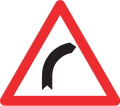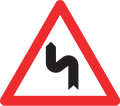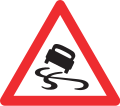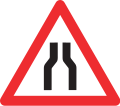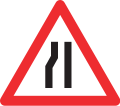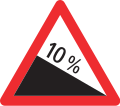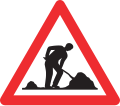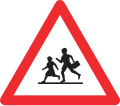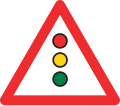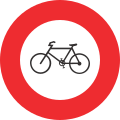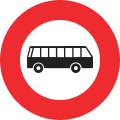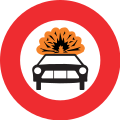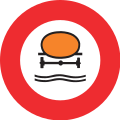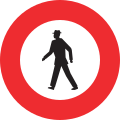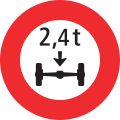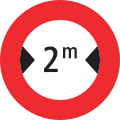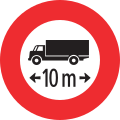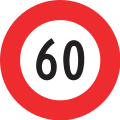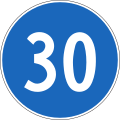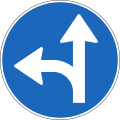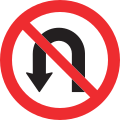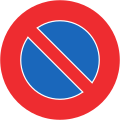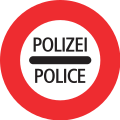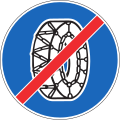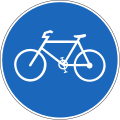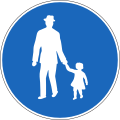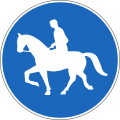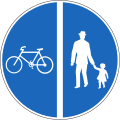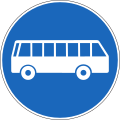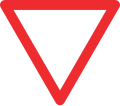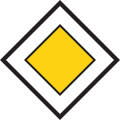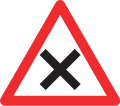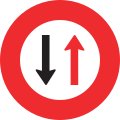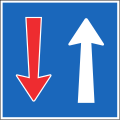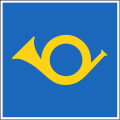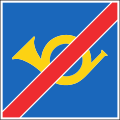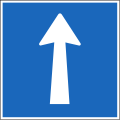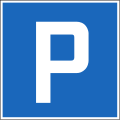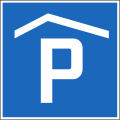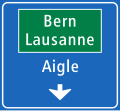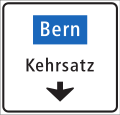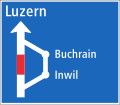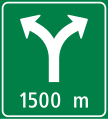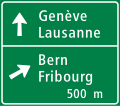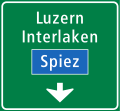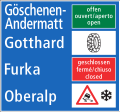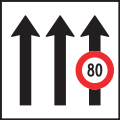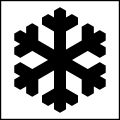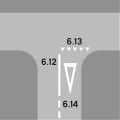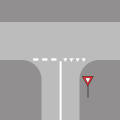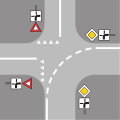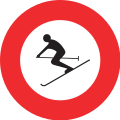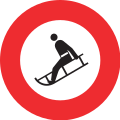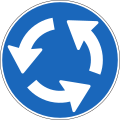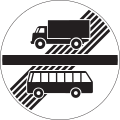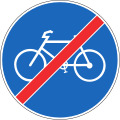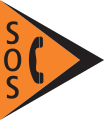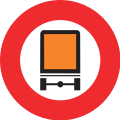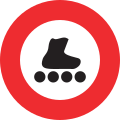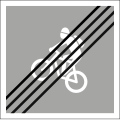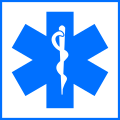Illustration of the road signals in Switzerland and Liechtenstein from 1980 to 2016
The picture table of the road signals in Switzerland and Liechtenstein from 1980 to 2021 shows the signals as they are in Switzerland in the Ordinance on Road Signalization of September 5, 1979 (SSV) and in Liechtenstein in the Road Signalization Ordinance of December 27, 1979 (SSV ) have been set.
This signaling catalog replaced the old catalog of May 31, 1963 in Switzerland on January 1, 1980 .
The 1980 catalog is - with changes - still valid today. The currently valid catalog, in which all changes up to 2016 (but not future ones as of 2021) have been taken into account, can be viewed under the picture table of road signals in Switzerland and Liechtenstein since 2016 .
structure
The structure below is based on the structure in the signaling catalog in Appendix 2 of the SSV, as it was valid on January 1, 1980.
| category | shape | No. | Art | colour | Example (s) | ||
|---|---|---|---|---|---|---|---|
| frame | background | content | |||||
| 1. Hazard signals | triangular | 1.01-1.18 | a) Dangerous road system | red | White | black |
|
| 1.22-1.30 | b) Other dangers |
|
|||||
| 2. Regulatory signals | round | 2.01-2.20 | a) Driving bans, size and weight restrictions | red | White | black |

|
| differently | 2.30-2.58 | b) Driving orders, parking restrictions | differently |
 
|
|||
| 2.60-2.65 | c) Special paths, bus lanes, light signal system for the temporary regulation of lanes |
 |
|||||
| 3. Right of way signals | differently | 3.01-3.25 | - | differently |
 
|
||
| 4. Warning signals | rectangular | 4.01-4.23 | a) Behavioral advice | white (thin) | green or blue | white or black |

|
| differently | 4.27-4.57 | b) Signposting on main and secondary roads | white (thin) | differently | white or black |
|
|
| differently | 4.60-4.71 | c) Signposting on motorways and motorways | white or black (thin) | differently | white or black |
|
|
| rectangular | 4.75-4.91 | d) Information notes | differently |

|
|||
| 5. Additional information on signals | rectangular | 5.01-5.16 | - | black (thin) | White | black |
 |
| 6. Markings and guidance systems | - | 6.01-6.31 | - | - | white yellow blue red |

|
|
design
The size of the signals and markings is defined in Appendix 1 of the SSV. Additional details (color, font, permissible variations, layout, etc.) are regulated by the corresponding technical standards.
The SNV font was used as the standard font until 2003, and ASTRA-Frutiger has been used since then .
Signalization catalog, status 1980
With a few exceptions, Switzerland and Liechtenstein have the same road signaling. Exceptions are marked as such.
1.xx danger signals
- Danger signals
1.06 Uneven road surface
1.10 Dangerous slope
1.14 construction site
1.22 pedestrian crossing
1.29 Crosswind
2.xx regulation signals
- Regulation signals
3.xx right of way signals
- Right of way signals
3.26 Traffic lights at level crossing, Liechtenstein only
( Austrian traffic lights )
4.xx warning signals
Liechtenstein does not contain the tables for 4.58 to 4.73 (motorways and motorways), as Liechtenstein does not have its own motorways and motorways. The location information given in these warning signals for illustration purposes comes from the Swiss Signaling Ordinance. The Liechtenstein Road Signaling Ordinance uses Liechtenstein localities for local destinations and Austrian and Swiss localities near the border for long-distance destinations.
- Warning signals
4.05 Bergpoststrasse
4.08 one-way street
4.09 dead end
4.11 Location of a pedestrian crossing
4.34 Signposts for diversions
4:47 sign « camping site »
4.79 campsite
4.83 Breakdown
4.84 gas station
4.89 youth hostel
5.xx Additional information on signals
- Additional information on signals
6.xx markings
- Markings
6.17 pedestrian crossing & 6.18 no-stopping line
Signals that were added or dropped in 1980
With the introduction of the new Signaling Ordinance 1979, which came into effect in 1980, the following changes were made compared to the old Ordinance of 1963 (last revision 1975):
Newly introduced signals
The numbering is based on the SSV from 1979.
- Signals introduced on January 1st, 1980
4.89 youth hostel
Signals canceled
The numbering is based on the 1963 ordinance on road signaling.
- Signals canceled on January 1, 1980
Adapted signals
Numbering in the old representation: SSV from 1963, numbering in the new representation: SSV from 1979.
1.22 pedestrian crossing
4.09 dead end
Renamed signals
Numbering in the old representation: SSV from 1963, numbering in the new representation: SSV from 1979.
- Signals renamed January 1, 1980
Subsequent changes and additions to the road signals
January 1, 1984 (AS 1983 1651)
The following signals were newly introduced on January 1, 1984 in the Swiss Signaling Ordinance as part of the ordinance on the amendment of road traffic regulations (Tempo 50 in urban areas) :
Newly introduced signals
- Signals introduced on January 1, 1984
This signal was introduced as part of the speed reduction in urban areas from 60 km / h to 50 km / h. Any existing 60 km / h signals had to be removed by June 30, 1984 - unless traffic safety is not endangered.
May 1, 1989 (AS 1989 438)
The following signals were repealed, newly introduced, renamed or adapted in the Swiss Signaling Ordinance on May 1, 1989:
Signals canceled
- Signals canceled on May 1, 1989
Newly introduced signals
- Signals introduced on May 1st, 1989
1.31 traffic jam
4.24 emergency lane (example)
The signals “Start of the speed limit zone” illustrated a 40 km / h zone at this point in time. In 2002 this was adjusted to 30 km / h.
Renamed signal
The following signals have been renamed:
- Signal renamed May 1, 1989
Adapted signal
The following signal has been adjusted:
- Signal adjusted for May 1st, 1989
March 15, 1992 (AS 1992 514)
The following signals were newly introduced on March 15, 1992 in the ordinance on road signaling (Signalisationsverordnung [SSV]) :
- Signals introduced on March 15, 1992
April 1, 1994 (AS 1994 816)
The following signal was renamed as part of the amendment to the Traffic Rules Ordinance (VRV) of March 7, 1994 in the Swiss Signalization Ordinance:
- Signal renamed April 1, 1994
April 1, 1994 (AS 1994 1103)
The following signals were newly introduced in the Swiss Signaling Ordinance on April 1, 1994 (it can be assumed that Liechtenstein also adjusted its SSV on this date):
- Signals introduced on April 1, 1994
October 1, 1995 (AS 1995 4420)
The following signals were repealed, newly introduced or renamed in the Swiss Signaling Ordinance as part of the new ordinance on the technical requirements for road vehicles from June 19, 1995 (VTS) to October 1, 1995 (it can be assumed that Liechtenstein will also have its SSV also adjusted):
Signals canceled
- Signals canceled on October 1, 1995
Existing signals must be replaced by December 31, 1998.
According to Art. 117, Paragraph 1 SSV in the 1979 version, the “stop signal under previous law” was only temporarily valid until January 1, 1985. Until then, all existing signals had to be replaced by 3.01 «Stop». However, it remained in the SSV until 1995, with the indication that existing signals would have to be replaced by December 31, 1998.
Newly introduced signals
- Signals introduced on October 1st, 1995
June 1, 1998 (AS 1998 1440)
The following signals were repealed, introduced or renamed in the Swiss Signaling Ordinance on June 1, 1998 (it can be assumed that Liechtenstein also adjusted its SSV on this date):
Signals canceled
- Signals canceled on June 1, 1998
Newly introduced signals
- Signals introduced on June 1, 1998
Renamed signals
- Signals renamed June 1, 1998
January 1, 2002 (AS 2001 2719)
The following signals were repealed, introduced or adjusted in the Swiss Signaling Ordinance on January 1, 2002 (it can be assumed that Liechtenstein also adjusted its SSV on this date):
Signals canceled
- Signals canceled on January 1, 2002
The signals 2.59.5 “encounter zone” and 2.59.6 “end of the encounter zone” took over their function. For the history of this adaptation see encounter zone # history .
Newly introduced signals
- Signals introduced on January 1st, 2002
Adapted signals
Signal 2.59.1 was only valid for zones with speed restrictions until the amendment. A 40 km / h zone was illustrated. Since then, 2.59.1 has been considered a general zone signal, so it can also be used for other zones as speed zones. In addition, when illustrating the speed zone , the speed was adjusted to 30 km / h, based on the 30 km / h zones , which were becoming more and more common.
- Signals adjusted for January 1, 2002
August 1, 2002 (AS 2002 1935)
The following signal was newly introduced on August 1, 2002 in the Swiss Signaling Ordinance:
- Signal introduced on August 1st, 2002
September 23, 2002 (AS 2002 3174)
The following signal was introduced in the Swiss Signaling Ordinance on September 23, 2002:
- Signal introduced on September 23, 2002
The corresponding paragraph ( Art. 65 Para. 10 SSV) reads: “An additional sign attached to the signal“ Ban on trucks ”(2.07) with the word“ excepted ”and the symbol“ S-traffic ”(5.55) indicates that vehicles and vehicle combinations which are marked with the corresponding symbol in accordance with Appendix 4 VTS2 at the front and rear are excluded from the signaled restriction. »
December 14, 2003 (AS 2003 4289)
The following signals were renamed in the Swiss Signaling Ordinance on December 14, 2003:
- Signals renamed December 14, 2003
March 1, 2006 (AS 2005 4495)
The following signals were repealed, introduced or adjusted in the Swiss Signaling Ordinance on March 1, 2006 (it can be assumed that Liechtenstein also adjusted its SSV on this date):
Signals canceled
- Signals canceled on March 1, 2006
As of 2017, the single lane board can still be found in isolated cases.
Newly introduced signals
- Signals introduced on March 1, 2006
Adapted signals
- Signal adjusted for March 1, 2006
The old tractor symbol symbolized a tractor without a driver's roof (silhouette of a Buehrer tractor ), which was replaced.
January 1, 2010 (AS 2009 4241)
The following signal was newly introduced in the Swiss Signaling Ordinance on March 1, 2006 (it can be assumed that Liechtenstein also adjusted its SSV on this date):
- Signal introduced on January 1st, 2010
January 1, 2016 (AS 2015 2459)
The following signals were repealed, introduced or adapted on January 1, 2016 in both the Swiss Signaling Ordinance and the Liechtenstein Road Signaling Ordinance:
Signals canceled
- Signals canceled on January 1, 2016
1.29 Crosswind
The federal government wanted to remove signals that offered no added value. The Federal Roads Office justified the repeal as follows:
- “Distance bars” in front of level crossings are unnecessary, the other danger signals that serve to warn of level crossings are sufficient.
- The “aircraft” signal is unnecessary where low-flying aircraft are to be expected and insufficient where aircraft taxiing must be expected.
- Compared to the “cross wind” signal, a wind sock makes more sense to alert drivers to precarious wind conditions.
- There is no need for the signals “Entry from the right” and “Entry from the left”. In the rare cases where a corresponding marking appears necessary, the signal 4.77 «Display of the lanes» is already used today.
- It is hardly relevant whether a level crossing is equipped with one track or several tracks. Therefore the distinction between “double St. Andrew's cross” (3.23, 3.25) and “single St. Andrew's cross” (3.22, 3.24) is unnecessary. The only new feature is the "St. Andrew's Cross" (3.22, 3.24).
- Ending parking with a parking disc is unnecessary; in practice, such areas are defined as parking zones (2.59.1 «Zone signal», 2.59.2 «End zone signal»).
Existing signals must be removed or replaced by December 31, 2020.
Newly introduced signals
- New signals introduced on January 1, 2016
4.09.1 Dead end with exceptions
Renamed signals
- Signals renamed January 1, 2016
January 1, 2021 (AS: still open)
" ASTRA Frutiger " is included in the ordinance as a standard font (Art. 102, Paragraph 5), until then it was only defined at the standard level.
Canceled signal
- Signals canceled on January 1, 2021
Due to the fact that the signal 4.17, which has been reformulated in the SSV, can be used in combination with the additional table 5.02 "Display of distance and direction", the signal 4.22 is superfluous and is removed.
Newly introduced signals
- New signals introduced on January 1, 2021
Cyclists and moped riders are permitted to turn right at red lights, provided that this is indicated by signal 5.18. The new “charging station” symbol identifies parking spaces that have a charging station for electric vehicles.
Renamed or adapted signals
- Signals renamed or adapted for January 1, 2021
- 4.25 is supplemented by “(example)”.
- A corresponding area for cyclists should be marked in front of light signals even if there is no cycle lane (6.26, example 2).
Discarded plans
2011
In 2011 a “total revision of the traffic regulations ordinance (VRV) and the signaling ordinance (SSV)” was submitted for consultation. The regulation on official road signaling should have replaced the existing SSV. The media response was quite high, especially due to the intention to abolish the signal “2.30.1 maximum speed 50 in general”. Village signs should have taken on this function. The aim was to align this rule with that of neighboring countries. The consultation was completed, but implementation did not follow.
2017
As of 2017, the opening of a consultation on the "adaptation of the traffic rules and road signaling as well as the technical requirements and approval tests for road vehicles" was planned for October 2017, but this was not followed up. Among other things, certain signals and markings should have been adapted and the signal catalog redesigned.
Individual evidence
- ↑ Ordinance on road signaling of September 5, 1979 (AS 1979 1961, i.e. on page 1961ff, in the PDF page 11ff.)
- ↑ Liechtenstein: Road Signalization Ordinance of December 27, 1979 (SSV)
- ↑ Ordinance on road signaling of May 31, 1963 (AS 1963 541, i.e. on page 541ff, in PDF page 9ff.)
- ↑ rel: «Frutiger» for the street . In: NZZ , January 20, 2003. Retrieved June 28, 2017.
- ↑ Frutiger honored with SOTA award . Microsoft Typography. Retrieved September 1, 2012.
- ↑ Road Signalization Ordinance (SSV) (PDF; 2.7 MB), page 98 ff.
- ↑ Ordinance on the amendment of the decree of road traffic (Tempo 50 in urban areas) (AS 1983 1651)
- ^ AS 1989 438
- ^ AS 1992 514
- ↑ Amendment of the Traffic Rules Ordinance (VRV) of March 7, 1994 (AS 1994 816)
- ^ AS 1994 1103
- ^ Ordinance on the technical requirements for road vehicles of June 19, 1995 (AS 1995 4420)
- ^ AS 1998 1440 (amendment of the SSV of April 1, 1998)
- ^ AS 2001 2719 (amendment of the SSV of September 28, 2001)
- ^ AS 2002 1935 (amendment of the SSV of May 15, 2002)
- ^ AS 2002 3174 (amendment of the SSV of September 20, 2002)
- ^ AS 2003 4289 (amendment of the SSV of November 12, 2003)
- ^ AS 2005 4495 (amendment of the SSV of August 17, 2005)
- ↑ AS 2009 4241 (amendment of the SSV of August 19, 2009)
- ^ AS 2015 2459 (amendment of the SSV of June 24, 2015)
- ↑ Liechtenstein SSV of December 27, 1979, version January 1, 2016
- ↑ Federal Roads Office FEDRO: Amendment of road traffic regulations (VRV, SSV, VTS and OBV). Detailed explanations.
- ↑ Federal Roads Office FEDRO (Ed.): Basic explanations on the E-StBV and E-BSSV . January 5, 2011 ( admin.ch [PDF]).
- ↑ Federal Roads Office FEDRO (ed.): Explanations on the E-BSSV . January 5, 2011 ( admin.ch [PDF]).
- ↑ place-name sign as speed signal | NZZ . In: Neue Zürcher Zeitung . January 6, 2011, ISSN 0376-6829 ( nzz.ch [accessed November 21, 2018]).
- ↑ A traffic sign gets people excited . In: Tages-Anzeiger, Tages-Anzeiger . May 15, 2011, ISSN 1422-9994 ( tagesanzeiger.ch [accessed on November 21, 2018]).
- ↑ Admin.ch: Completed consultations 2011 , accessed on October 19, 2017
- ↑ Admin.ch: Planned consultations , accessed on October 19, 2017
